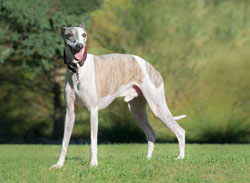Whippets are medium-sized dogs covered in dense, smooth coats. Coat colors can include red, black, light brown, brindle, white, slate, or tiger-striped, and they can be solid or mixed. These dogs have slender heads, long muzzles, rose ears, and long, tapered tails. Their eyes are large, dark, and oval. Whippets measure 18 to 22 inches tall at the shoulder and weigh 25 to 35 pounds.
Charming, relaxed, and well mannered, the Whippet makes a great house pet.
Obedient, demonstrative, and devoted, the Whippet makes a great house pet for families in search of a quiet, gentle, and loving dog. They are great with children and are calm when indoors. When outside, however, the Whippet loves to run, roam, and play.
Whippets look very much like medium-sized Greyhounds. They are the fasted domesticated animal in the breed's weight bracket, capable of running up to 35 or 40 mph.
Charming, relaxed, and well mannered, the Whippet makes a great house pet. These dogs get along very well with most people, including children and other dogs, and they love to be on the receiving end of affectionate and attention. This breed is very welcoming and is not an effective watchdog. Even though they are very friendly in general, Whippets tend to choose one family member above the others and will make it clear where their loyalty lies.
Whippets are very energetic and love to run, but they also enjoy cuddling on the couch and taking a nap with family members. These dogs even do well in city apartments, provided they are taken for a fast walk or run every day. They are capable of great intensity during dog sports and are naturally athletic.
Because of the breed's strong instinctual desire to chase small animals, Whippets should be kept on a tight leash or inside a securely fenced yard at all times when outdoors. These dogs will not hesitate to pursue a rabbit or neighborhood cat, and this puts them and other animals in danger.
Whippets are a generally healthy breed, although they are prone to sunburn because their coat is so short. For this same reason, and because they have minimal fat, they are sensitive to the cold and should wear a sweater during winter walks. Additionally, these dogs are prone to lacerations and are sensitive to anesthesia.
These dogs are also prone to hypothyroidism and congenital deafness. Neither condition should result in death, but both can negatively affect quality of life. The breed is also more likely than some other dogs to develop certain eye conditions, such as progressive retinal atrophy and corneal dystrophy.
Regular exercise, proper nutrition, up-to-date vaccinations, and routine veterinary visits all help ensure the Whippet lives to be 12 to 15 years old.
Easy to train, Whippets are fast learners. They are also independent and may be challenging to housetrain. The problem with housetraining primarily stems from the breed's refusal to go outside when it is too wet or cold outside. Walking the Whippet on a strict schedule, regardless of weather conditions, will help a lot.
These dogs are very clean and don't engage in many inappropriate behaviors. However, the breed's intelligence means it won't take long for the Whippet to figure out how to open drawers, locked doors, and cabinets. Storing harmful chemicals out of reach is essential.
To ensure successful training, sessions should be fun and short and harsh corrections should be avoided at all times. These dogs are very sensitive and will quickly shut down when criticized or scolded. Positive reinforcement techniques and kindness are much more effective, and consistency is key.
Whippets are one of the easiest dog breeds to groom. They have very fine and short hair that requires minimal care, and they are free of the "doggy odor" that bothers so many people. A quick brushing once a week with a rubber hound mitt is usually sufficient to keep their coat healthy and attractive. Shedding is minimal, but keeping a lint roller close by is a good idea.
These dogs rarely need bathing. If the Whippet decides to roll around in tree sap, garbage, or something else stinky or sticky, a quick wash with a pH-balanced canine shampoo will gently clean the coat without causing skin irritation. This breed should be rinsed thoroughly to remove all traces of soap from the coat and skin.
To protect the teeth and gums and keep the Whippet's breath smelling fresh, the teeth should be brushed every day with a canine toothpaste and toothbrush. Additionally, the ears need checking weekly for signs of ear infection and wax accumulation, and the nails should be trimmed every couple of weeks to prevent painful breaks and snags.
Originally used to hunt rabbits, Whippets were developed in England in the 1800s from a mix of terrier breeds and Greyhounds. Because they were small and easy to care for, they became extremely popular with miners and the working class. Whippets were sometimes used for other purposes.
The breed was crossed with ratting terriers to increase its gameness and quickness, and the Whippet soon began rag racing. In fact, these dogs were often referred to as the "poor man's race horse." After English mill operators of Massachusetts brought the breed to America, the state became the center of U.S. Whippet racing. Later, the sport drifted south to Baltimore and other parts of Maryland.
Following the breed's official recognition in 1888, the Whippet became increasingly popular. The breed was crossed again with the Italian Greyhound to further refine its appearance. Today, these dogs are highly valued family companions, show dogs, racers, and lure coursers. Although Whippet racing remains popular, it has never achieved the appeal of Greyhound racing.

